Strategic Management Techniques: IKEA’s Case
VerifiedAdded on 2023/05/29
|12
|2389
|332
AI Summary
This report deals with the analysis of the external environment of IKEA which is a Swedish entity operating as a leading retail of home furnishing products, using the prominent techniques of strategic management i.e. PESTLE analysis and Porter’s five forces analysis.
Contribute Materials
Your contribution can guide someone’s learning journey. Share your
documents today.
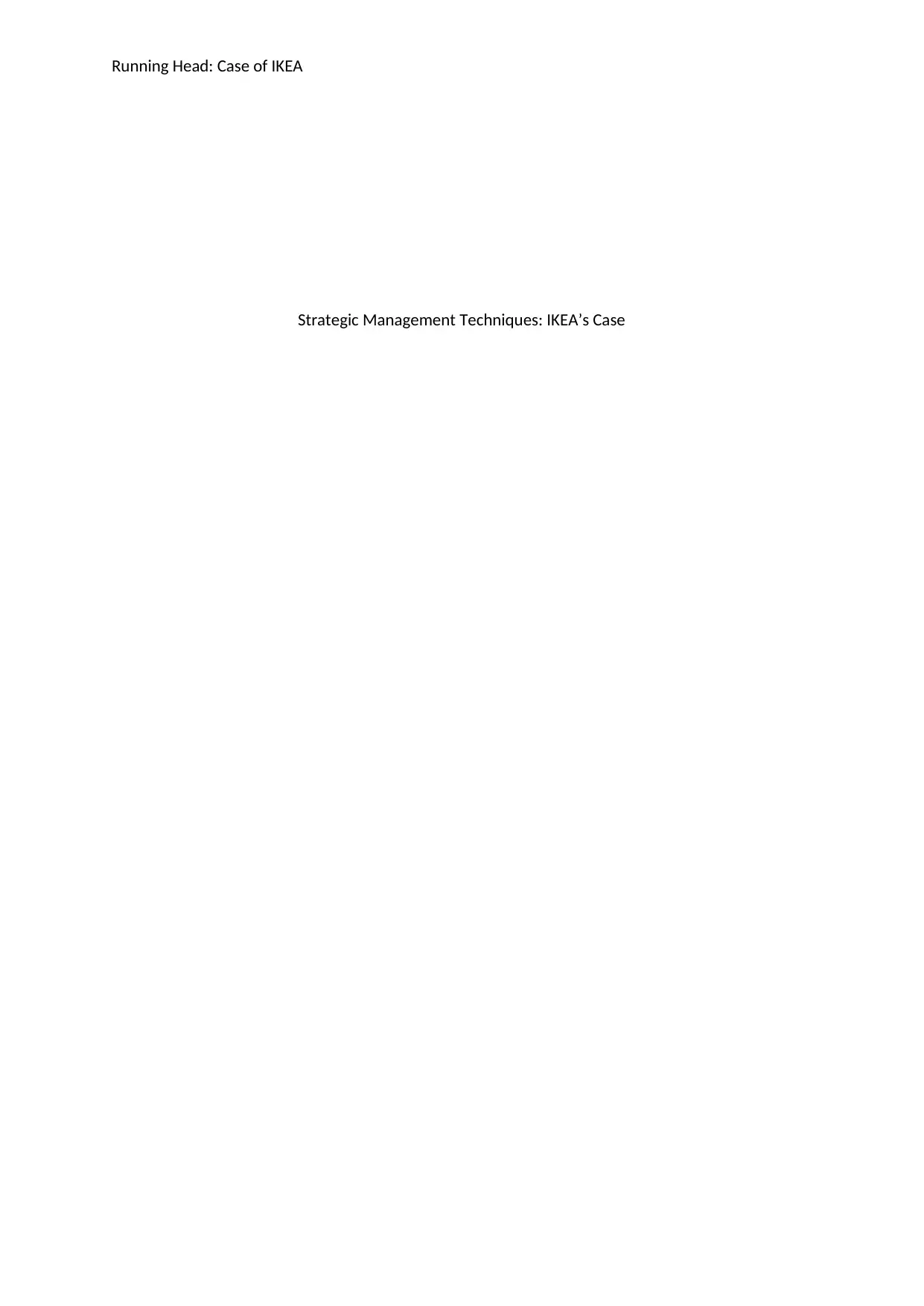
Running Head: Case of IKEA
Strategic Management Techniques: IKEA’s Case
Strategic Management Techniques: IKEA’s Case
Secure Best Marks with AI Grader
Need help grading? Try our AI Grader for instant feedback on your assignments.
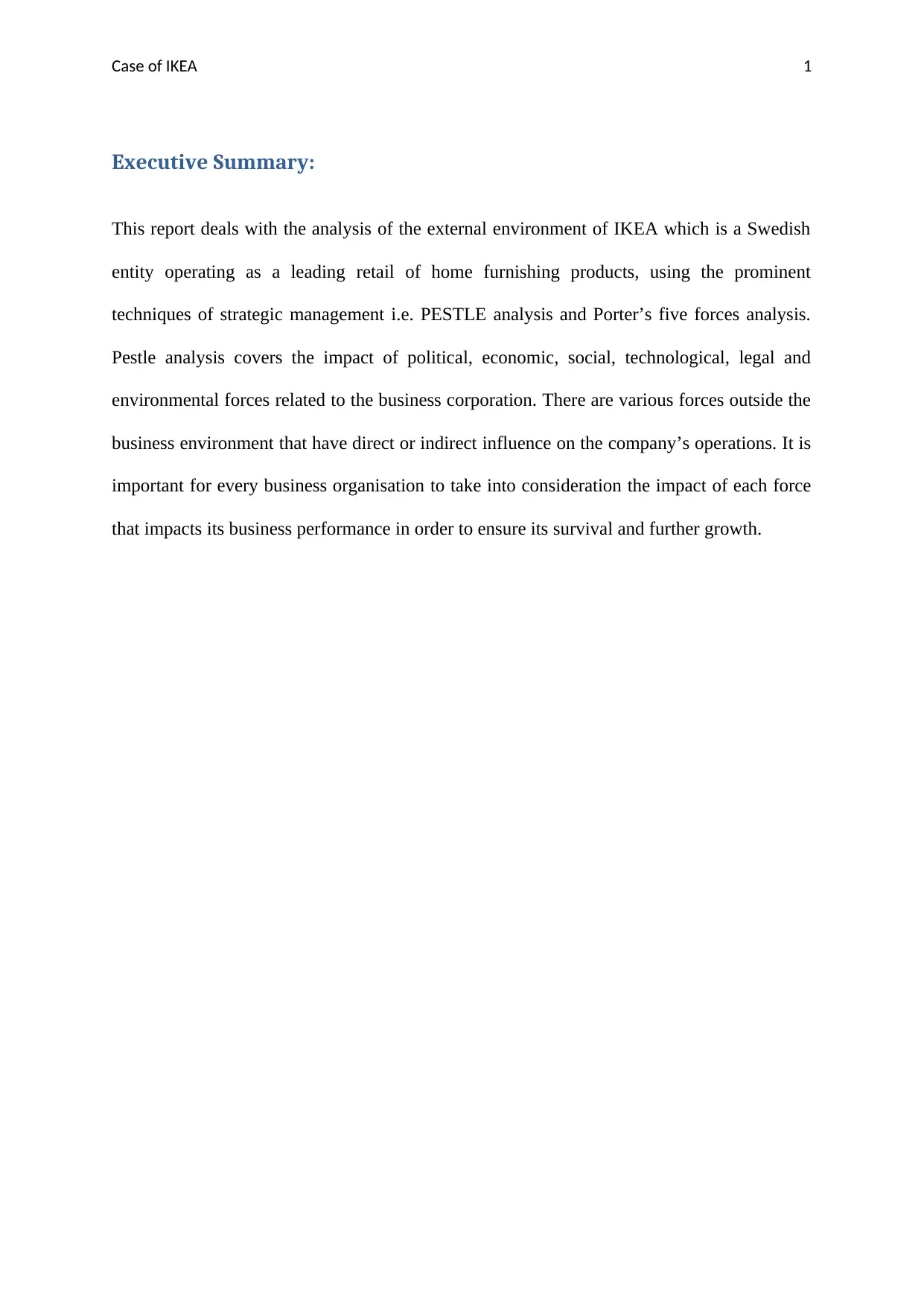
Case of IKEA 1
Executive Summary:
This report deals with the analysis of the external environment of IKEA which is a Swedish
entity operating as a leading retail of home furnishing products, using the prominent
techniques of strategic management i.e. PESTLE analysis and Porter’s five forces analysis.
Pestle analysis covers the impact of political, economic, social, technological, legal and
environmental forces related to the business corporation. There are various forces outside the
business environment that have direct or indirect influence on the company’s operations. It is
important for every business organisation to take into consideration the impact of each force
that impacts its business performance in order to ensure its survival and further growth.
Executive Summary:
This report deals with the analysis of the external environment of IKEA which is a Swedish
entity operating as a leading retail of home furnishing products, using the prominent
techniques of strategic management i.e. PESTLE analysis and Porter’s five forces analysis.
Pestle analysis covers the impact of political, economic, social, technological, legal and
environmental forces related to the business corporation. There are various forces outside the
business environment that have direct or indirect influence on the company’s operations. It is
important for every business organisation to take into consideration the impact of each force
that impacts its business performance in order to ensure its survival and further growth.
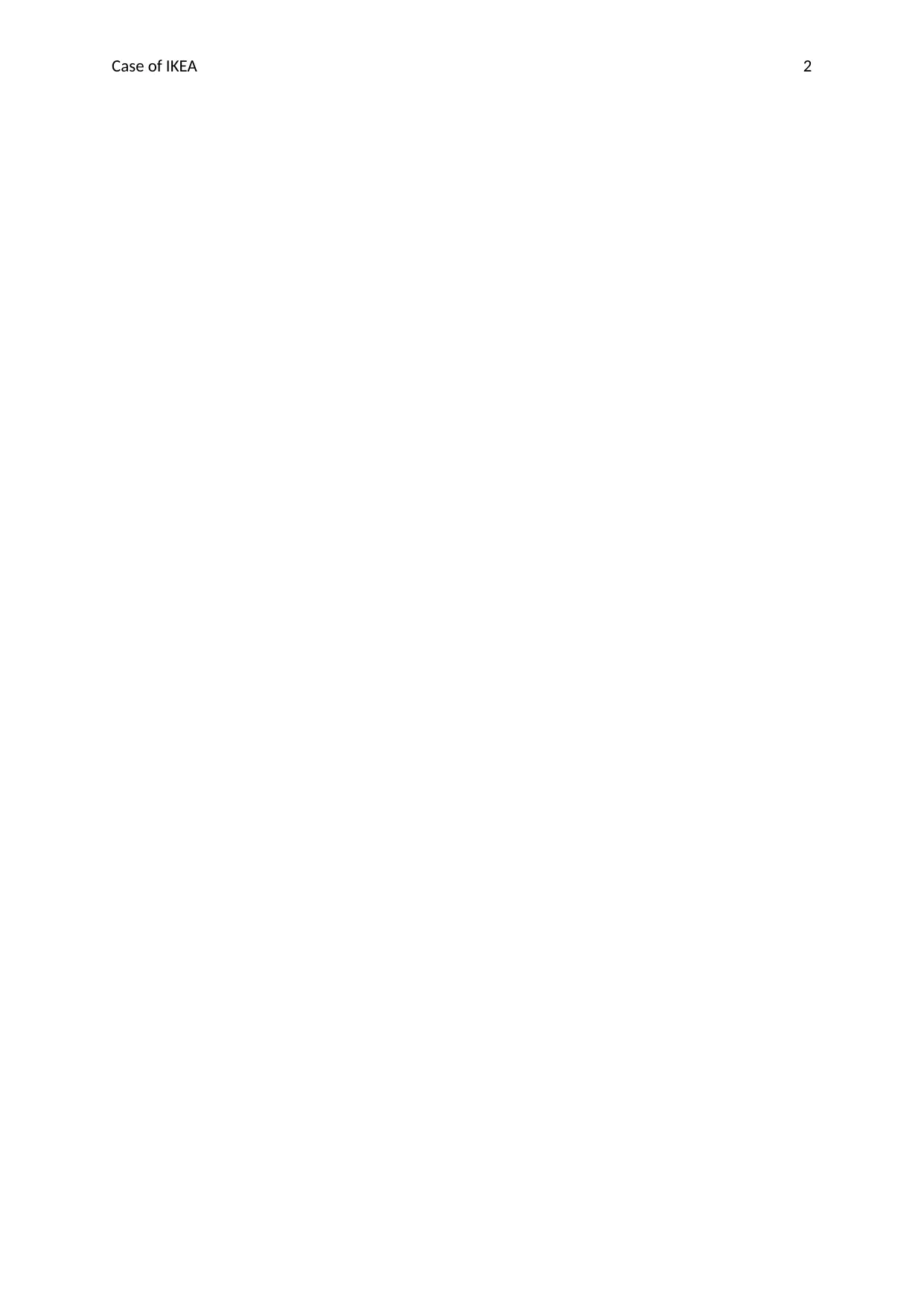
Case of IKEA 2
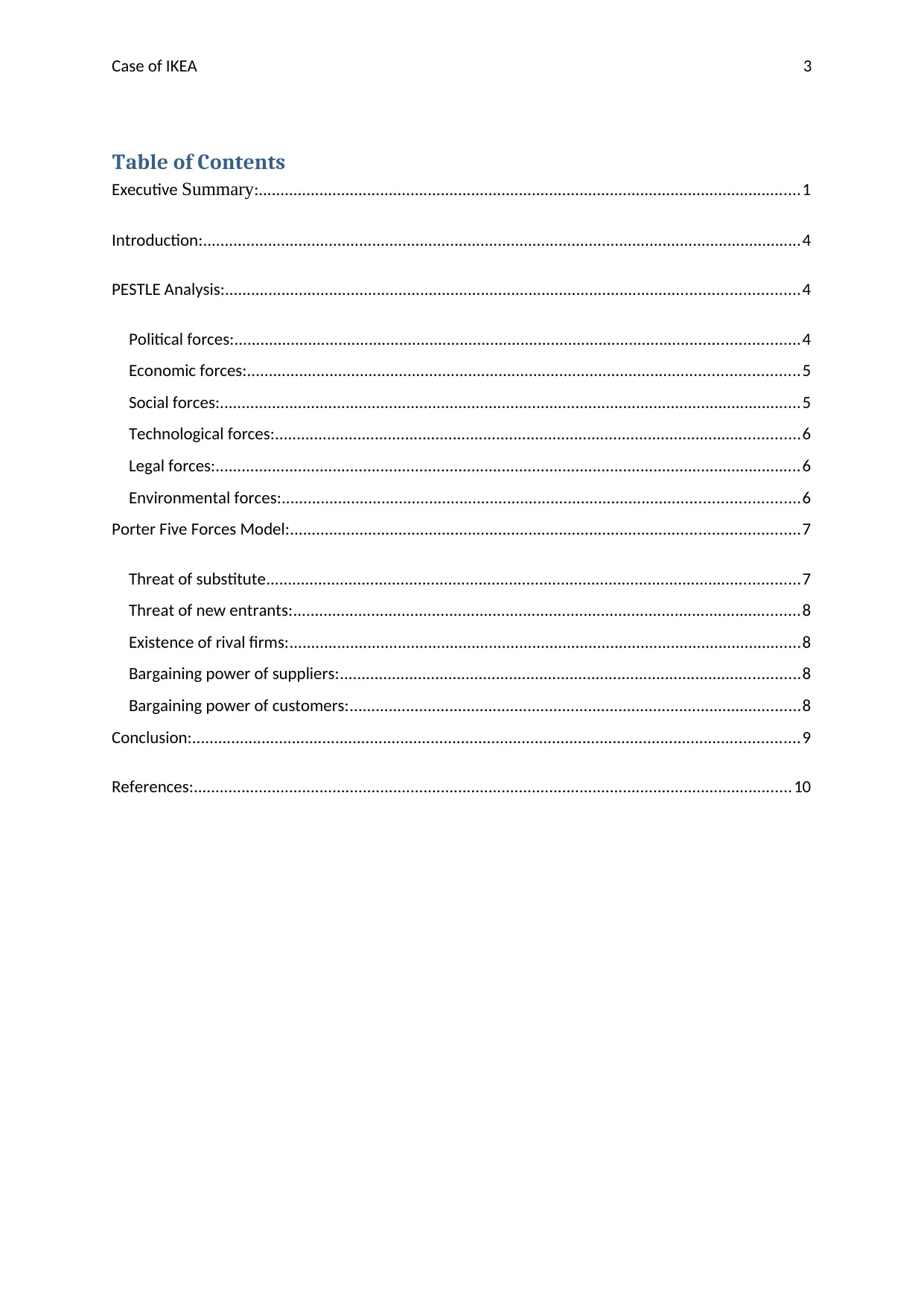
Case of IKEA 3
Table of Contents
Executive Summary:.............................................................................................................................1
Introduction:..........................................................................................................................................4
PESTLE Analysis:....................................................................................................................................4
Political forces:..................................................................................................................................4
Economic forces:...............................................................................................................................5
Social forces:......................................................................................................................................5
Technological forces:.........................................................................................................................6
Legal forces:.......................................................................................................................................6
Environmental forces:.......................................................................................................................6
Porter Five Forces Model:.....................................................................................................................7
Threat of substitute...........................................................................................................................7
Threat of new entrants:.....................................................................................................................8
Existence of rival firms:......................................................................................................................8
Bargaining power of suppliers:..........................................................................................................8
Bargaining power of customers:........................................................................................................8
Conclusion:............................................................................................................................................9
References:..........................................................................................................................................10
Table of Contents
Executive Summary:.............................................................................................................................1
Introduction:..........................................................................................................................................4
PESTLE Analysis:....................................................................................................................................4
Political forces:..................................................................................................................................4
Economic forces:...............................................................................................................................5
Social forces:......................................................................................................................................5
Technological forces:.........................................................................................................................6
Legal forces:.......................................................................................................................................6
Environmental forces:.......................................................................................................................6
Porter Five Forces Model:.....................................................................................................................7
Threat of substitute...........................................................................................................................7
Threat of new entrants:.....................................................................................................................8
Existence of rival firms:......................................................................................................................8
Bargaining power of suppliers:..........................................................................................................8
Bargaining power of customers:........................................................................................................8
Conclusion:............................................................................................................................................9
References:..........................................................................................................................................10
Secure Best Marks with AI Grader
Need help grading? Try our AI Grader for instant feedback on your assignments.
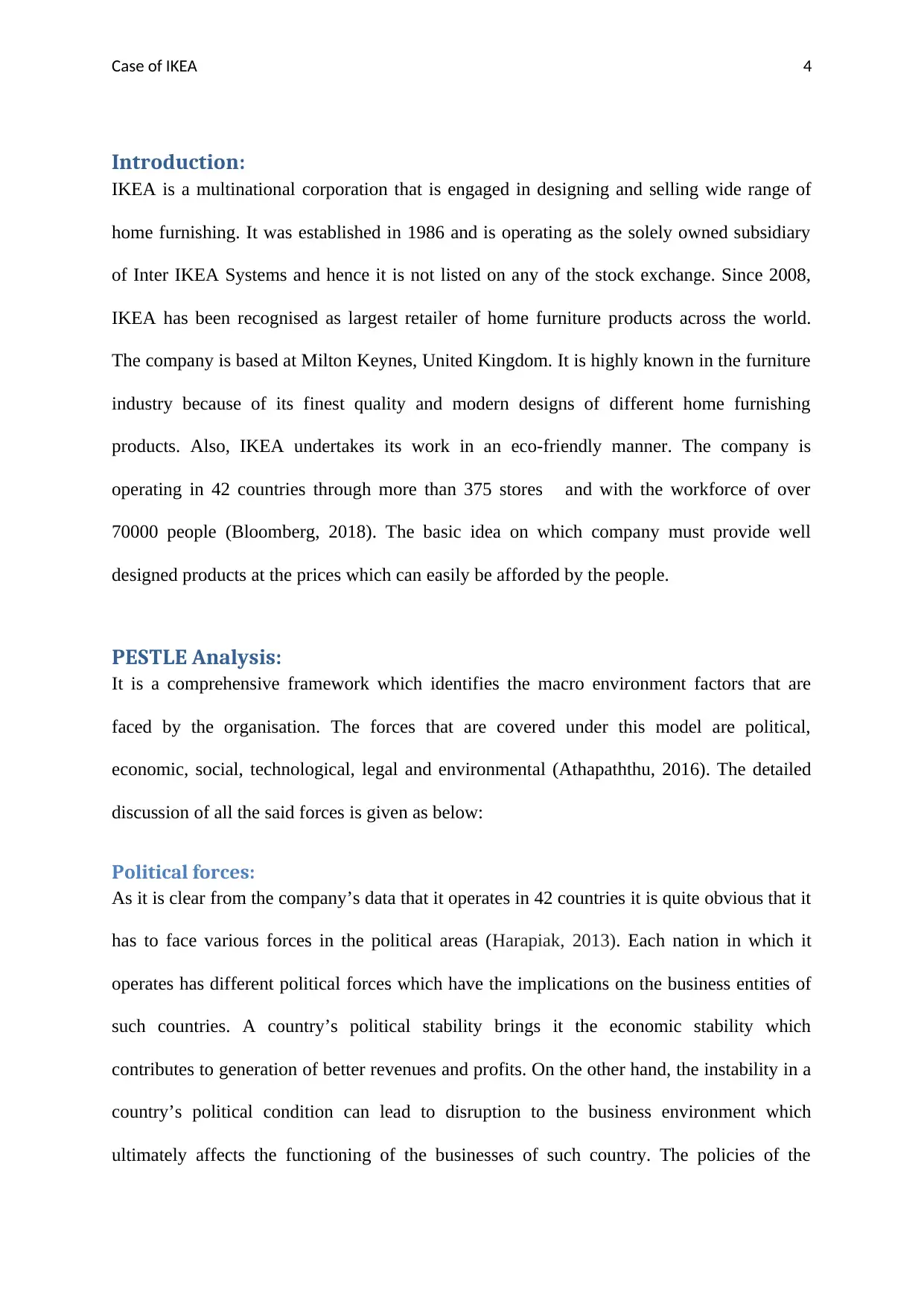
Case of IKEA 4
Introduction:
IKEA is a multinational corporation that is engaged in designing and selling wide range of
home furnishing. It was established in 1986 and is operating as the solely owned subsidiary
of Inter IKEA Systems and hence it is not listed on any of the stock exchange. Since 2008,
IKEA has been recognised as largest retailer of home furniture products across the world.
The company is based at Milton Keynes, United Kingdom. It is highly known in the furniture
industry because of its finest quality and modern designs of different home furnishing
products. Also, IKEA undertakes its work in an eco-friendly manner. The company is
operating in 42 countries through more than 375 stores and with the workforce of over
70000 people (Bloomberg, 2018). The basic idea on which company must provide well
designed products at the prices which can easily be afforded by the people.
PESTLE Analysis:
It is a comprehensive framework which identifies the macro environment factors that are
faced by the organisation. The forces that are covered under this model are political,
economic, social, technological, legal and environmental (Athapaththu, 2016). The detailed
discussion of all the said forces is given as below:
Political forces:
As it is clear from the company’s data that it operates in 42 countries it is quite obvious that it
has to face various forces in the political areas (Harapiak, 2013). Each nation in which it
operates has different political forces which have the implications on the business entities of
such countries. A country’s political stability brings it the economic stability which
contributes to generation of better revenues and profits. On the other hand, the instability in a
country’s political condition can lead to disruption to the business environment which
ultimately affects the functioning of the businesses of such country. The policies of the
Introduction:
IKEA is a multinational corporation that is engaged in designing and selling wide range of
home furnishing. It was established in 1986 and is operating as the solely owned subsidiary
of Inter IKEA Systems and hence it is not listed on any of the stock exchange. Since 2008,
IKEA has been recognised as largest retailer of home furniture products across the world.
The company is based at Milton Keynes, United Kingdom. It is highly known in the furniture
industry because of its finest quality and modern designs of different home furnishing
products. Also, IKEA undertakes its work in an eco-friendly manner. The company is
operating in 42 countries through more than 375 stores and with the workforce of over
70000 people (Bloomberg, 2018). The basic idea on which company must provide well
designed products at the prices which can easily be afforded by the people.
PESTLE Analysis:
It is a comprehensive framework which identifies the macro environment factors that are
faced by the organisation. The forces that are covered under this model are political,
economic, social, technological, legal and environmental (Athapaththu, 2016). The detailed
discussion of all the said forces is given as below:
Political forces:
As it is clear from the company’s data that it operates in 42 countries it is quite obvious that it
has to face various forces in the political areas (Harapiak, 2013). Each nation in which it
operates has different political forces which have the implications on the business entities of
such countries. A country’s political stability brings it the economic stability which
contributes to generation of better revenues and profits. On the other hand, the instability in a
country’s political condition can lead to disruption to the business environment which
ultimately affects the functioning of the businesses of such country. The policies of the
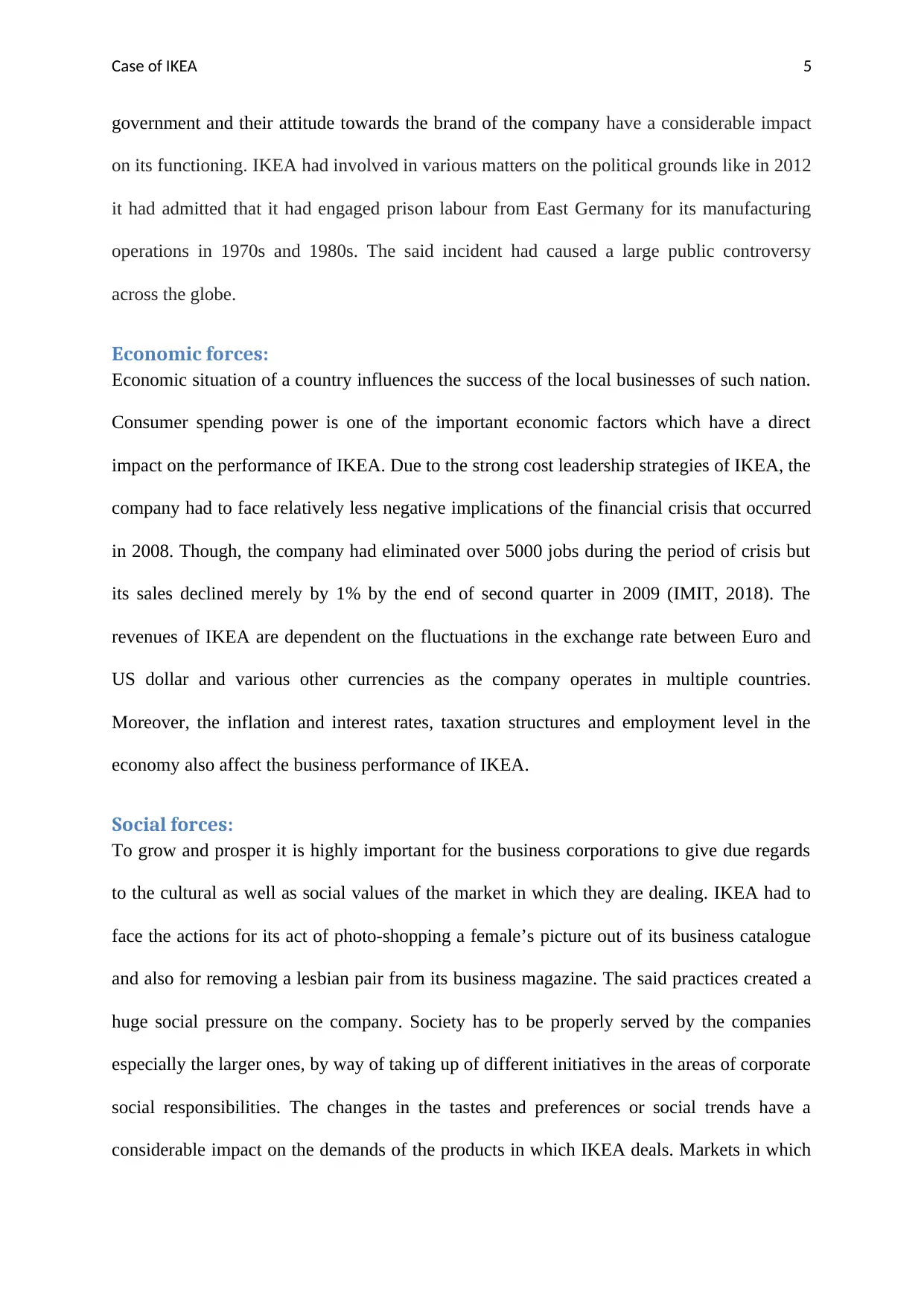
Case of IKEA 5
government and their attitude towards the brand of the company have a considerable impact
on its functioning. IKEA had involved in various matters on the political grounds like in 2012
it had admitted that it had engaged prison labour from East Germany for its manufacturing
operations in 1970s and 1980s. The said incident had caused a large public controversy
across the globe.
Economic forces:
Economic situation of a country influences the success of the local businesses of such nation.
Consumer spending power is one of the important economic factors which have a direct
impact on the performance of IKEA. Due to the strong cost leadership strategies of IKEA, the
company had to face relatively less negative implications of the financial crisis that occurred
in 2008. Though, the company had eliminated over 5000 jobs during the period of crisis but
its sales declined merely by 1% by the end of second quarter in 2009 (IMIT, 2018). The
revenues of IKEA are dependent on the fluctuations in the exchange rate between Euro and
US dollar and various other currencies as the company operates in multiple countries.
Moreover, the inflation and interest rates, taxation structures and employment level in the
economy also affect the business performance of IKEA.
Social forces:
To grow and prosper it is highly important for the business corporations to give due regards
to the cultural as well as social values of the market in which they are dealing. IKEA had to
face the actions for its act of photo-shopping a female’s picture out of its business catalogue
and also for removing a lesbian pair from its business magazine. The said practices created a
huge social pressure on the company. Society has to be properly served by the companies
especially the larger ones, by way of taking up of different initiatives in the areas of corporate
social responsibilities. The changes in the tastes and preferences or social trends have a
considerable impact on the demands of the products in which IKEA deals. Markets in which
government and their attitude towards the brand of the company have a considerable impact
on its functioning. IKEA had involved in various matters on the political grounds like in 2012
it had admitted that it had engaged prison labour from East Germany for its manufacturing
operations in 1970s and 1980s. The said incident had caused a large public controversy
across the globe.
Economic forces:
Economic situation of a country influences the success of the local businesses of such nation.
Consumer spending power is one of the important economic factors which have a direct
impact on the performance of IKEA. Due to the strong cost leadership strategies of IKEA, the
company had to face relatively less negative implications of the financial crisis that occurred
in 2008. Though, the company had eliminated over 5000 jobs during the period of crisis but
its sales declined merely by 1% by the end of second quarter in 2009 (IMIT, 2018). The
revenues of IKEA are dependent on the fluctuations in the exchange rate between Euro and
US dollar and various other currencies as the company operates in multiple countries.
Moreover, the inflation and interest rates, taxation structures and employment level in the
economy also affect the business performance of IKEA.
Social forces:
To grow and prosper it is highly important for the business corporations to give due regards
to the cultural as well as social values of the market in which they are dealing. IKEA had to
face the actions for its act of photo-shopping a female’s picture out of its business catalogue
and also for removing a lesbian pair from its business magazine. The said practices created a
huge social pressure on the company. Society has to be properly served by the companies
especially the larger ones, by way of taking up of different initiatives in the areas of corporate
social responsibilities. The changes in the tastes and preferences or social trends have a
considerable impact on the demands of the products in which IKEA deals. Markets in which
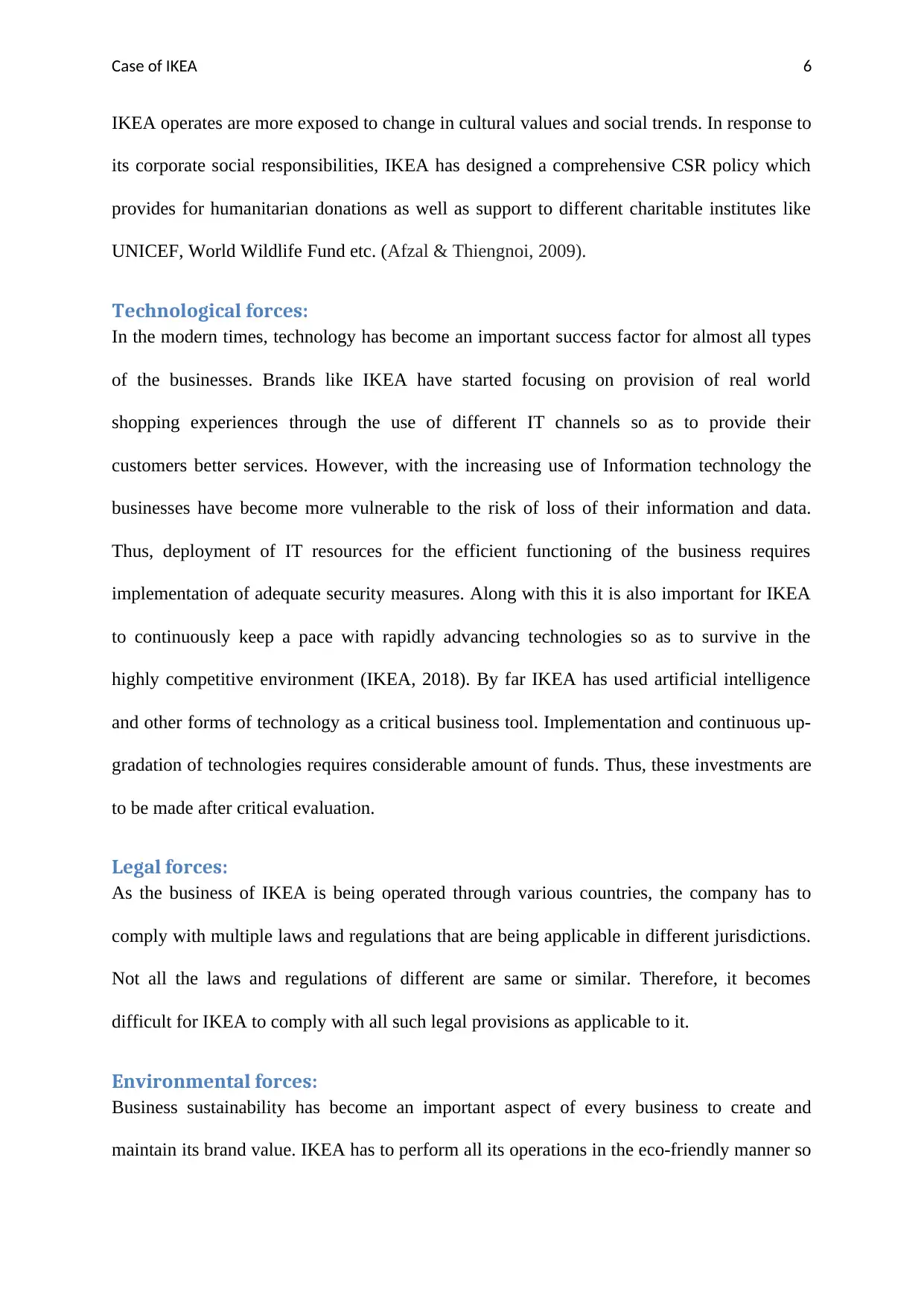
Case of IKEA 6
IKEA operates are more exposed to change in cultural values and social trends. In response to
its corporate social responsibilities, IKEA has designed a comprehensive CSR policy which
provides for humanitarian donations as well as support to different charitable institutes like
UNICEF, World Wildlife Fund etc. (Afzal & Thiengnoi, 2009).
Technological forces:
In the modern times, technology has become an important success factor for almost all types
of the businesses. Brands like IKEA have started focusing on provision of real world
shopping experiences through the use of different IT channels so as to provide their
customers better services. However, with the increasing use of Information technology the
businesses have become more vulnerable to the risk of loss of their information and data.
Thus, deployment of IT resources for the efficient functioning of the business requires
implementation of adequate security measures. Along with this it is also important for IKEA
to continuously keep a pace with rapidly advancing technologies so as to survive in the
highly competitive environment (IKEA, 2018). By far IKEA has used artificial intelligence
and other forms of technology as a critical business tool. Implementation and continuous up-
gradation of technologies requires considerable amount of funds. Thus, these investments are
to be made after critical evaluation.
Legal forces:
As the business of IKEA is being operated through various countries, the company has to
comply with multiple laws and regulations that are being applicable in different jurisdictions.
Not all the laws and regulations of different are same or similar. Therefore, it becomes
difficult for IKEA to comply with all such legal provisions as applicable to it.
Environmental forces:
Business sustainability has become an important aspect of every business to create and
maintain its brand value. IKEA has to perform all its operations in the eco-friendly manner so
IKEA operates are more exposed to change in cultural values and social trends. In response to
its corporate social responsibilities, IKEA has designed a comprehensive CSR policy which
provides for humanitarian donations as well as support to different charitable institutes like
UNICEF, World Wildlife Fund etc. (Afzal & Thiengnoi, 2009).
Technological forces:
In the modern times, technology has become an important success factor for almost all types
of the businesses. Brands like IKEA have started focusing on provision of real world
shopping experiences through the use of different IT channels so as to provide their
customers better services. However, with the increasing use of Information technology the
businesses have become more vulnerable to the risk of loss of their information and data.
Thus, deployment of IT resources for the efficient functioning of the business requires
implementation of adequate security measures. Along with this it is also important for IKEA
to continuously keep a pace with rapidly advancing technologies so as to survive in the
highly competitive environment (IKEA, 2018). By far IKEA has used artificial intelligence
and other forms of technology as a critical business tool. Implementation and continuous up-
gradation of technologies requires considerable amount of funds. Thus, these investments are
to be made after critical evaluation.
Legal forces:
As the business of IKEA is being operated through various countries, the company has to
comply with multiple laws and regulations that are being applicable in different jurisdictions.
Not all the laws and regulations of different are same or similar. Therefore, it becomes
difficult for IKEA to comply with all such legal provisions as applicable to it.
Environmental forces:
Business sustainability has become an important aspect of every business to create and
maintain its brand value. IKEA has to perform all its operations in the eco-friendly manner so
Paraphrase This Document
Need a fresh take? Get an instant paraphrase of this document with our AI Paraphraser

Case of IKEA 7
as to avoid any penalties or fines from the environmental regulators which can ultimately
hamper the overall business performance.
Porter Five Forces Model:
After carrying out the PESTLE analysis, Porter five forces model will be used to identify
various issues industry wide that can affect the business functioning of the organisation.
These threats are: threat of substitutes of the products in which company is dealing, threat of
entries of new firms, threats of intense competition among within the industry in which
company is operating, bargaining powers of the potential suppliers and the bargaining power
of the potential customers of the company. All these forces exist in nearly all types of
industries and every business corporation has to face some or all of the said forces (Porter,
2008). Though IKEA is financially sound as well as it has a firm brand image and the
strategies like cost leadership and product quality has allowed the company to become a
leader in the market but it also has to face certain forces that have been incorporated in
porter’s model (Palepu & Healy, 2007). Following are the forces that exist in the furniture
manufacturing industry and are being faced by the business units of this industry:
Threat of substitute:
This kind of risk is low for the products supplied by IKEA because in the market there are
not many products available which can meet the demands of the customers. The major
reasons behind the low risk in this area are the IKEA’s brand image and the availability of
large number of products under a single roof. Also, the prices of the company are affordable
by its customers and the quality of services it provides to its customers helps it to keep the
substitution risk lower (Dudovskiy, 2017).
as to avoid any penalties or fines from the environmental regulators which can ultimately
hamper the overall business performance.
Porter Five Forces Model:
After carrying out the PESTLE analysis, Porter five forces model will be used to identify
various issues industry wide that can affect the business functioning of the organisation.
These threats are: threat of substitutes of the products in which company is dealing, threat of
entries of new firms, threats of intense competition among within the industry in which
company is operating, bargaining powers of the potential suppliers and the bargaining power
of the potential customers of the company. All these forces exist in nearly all types of
industries and every business corporation has to face some or all of the said forces (Porter,
2008). Though IKEA is financially sound as well as it has a firm brand image and the
strategies like cost leadership and product quality has allowed the company to become a
leader in the market but it also has to face certain forces that have been incorporated in
porter’s model (Palepu & Healy, 2007). Following are the forces that exist in the furniture
manufacturing industry and are being faced by the business units of this industry:
Threat of substitute:
This kind of risk is low for the products supplied by IKEA because in the market there are
not many products available which can meet the demands of the customers. The major
reasons behind the low risk in this area are the IKEA’s brand image and the availability of
large number of products under a single roof. Also, the prices of the company are affordable
by its customers and the quality of services it provides to its customers helps it to keep the
substitution risk lower (Dudovskiy, 2017).
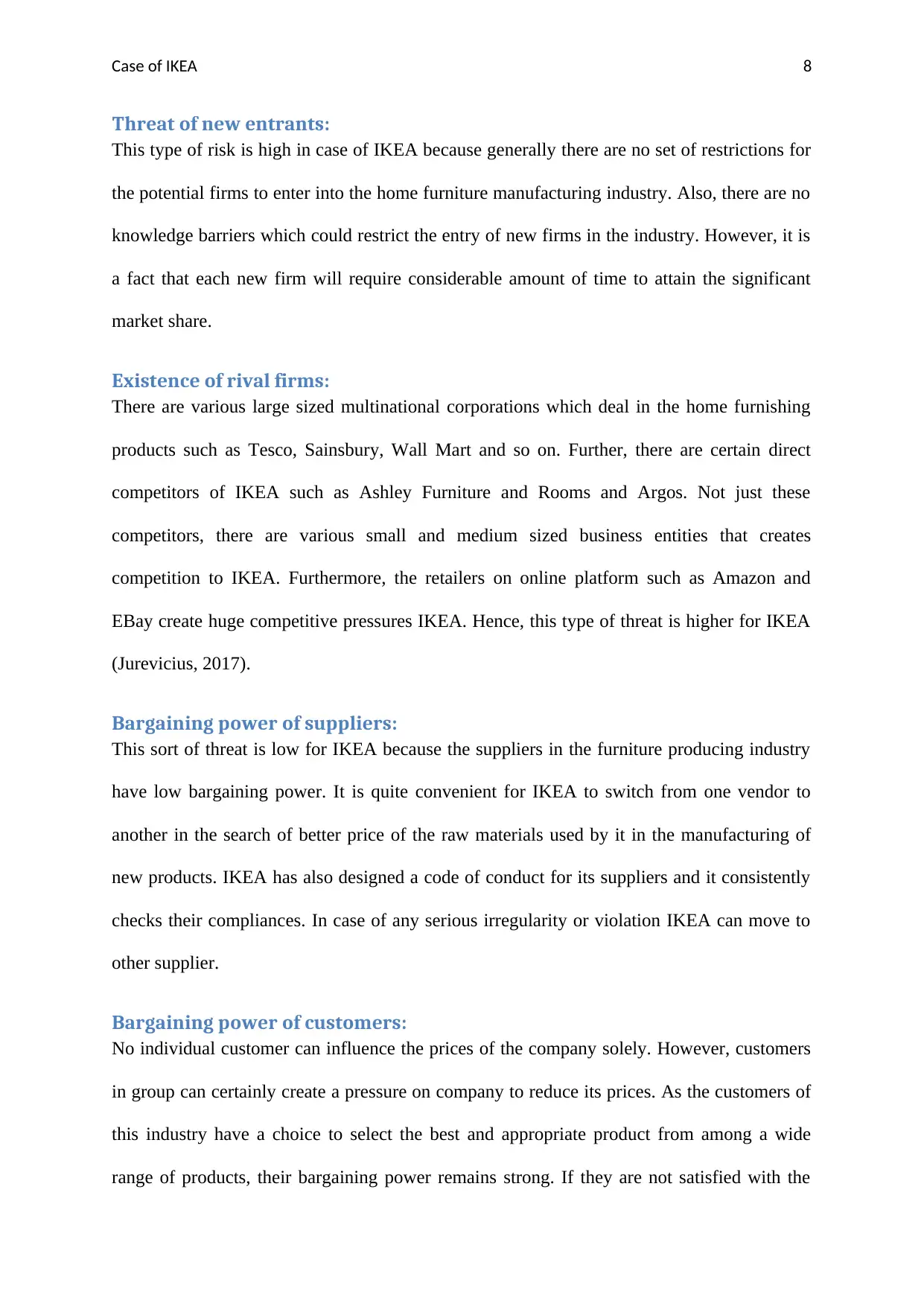
Case of IKEA 8
Threat of new entrants:
This type of risk is high in case of IKEA because generally there are no set of restrictions for
the potential firms to enter into the home furniture manufacturing industry. Also, there are no
knowledge barriers which could restrict the entry of new firms in the industry. However, it is
a fact that each new firm will require considerable amount of time to attain the significant
market share.
Existence of rival firms:
There are various large sized multinational corporations which deal in the home furnishing
products such as Tesco, Sainsbury, Wall Mart and so on. Further, there are certain direct
competitors of IKEA such as Ashley Furniture and Rooms and Argos. Not just these
competitors, there are various small and medium sized business entities that creates
competition to IKEA. Furthermore, the retailers on online platform such as Amazon and
EBay create huge competitive pressures IKEA. Hence, this type of threat is higher for IKEA
(Jurevicius, 2017).
Bargaining power of suppliers:
This sort of threat is low for IKEA because the suppliers in the furniture producing industry
have low bargaining power. It is quite convenient for IKEA to switch from one vendor to
another in the search of better price of the raw materials used by it in the manufacturing of
new products. IKEA has also designed a code of conduct for its suppliers and it consistently
checks their compliances. In case of any serious irregularity or violation IKEA can move to
other supplier.
Bargaining power of customers:
No individual customer can influence the prices of the company solely. However, customers
in group can certainly create a pressure on company to reduce its prices. As the customers of
this industry have a choice to select the best and appropriate product from among a wide
range of products, their bargaining power remains strong. If they are not satisfied with the
Threat of new entrants:
This type of risk is high in case of IKEA because generally there are no set of restrictions for
the potential firms to enter into the home furniture manufacturing industry. Also, there are no
knowledge barriers which could restrict the entry of new firms in the industry. However, it is
a fact that each new firm will require considerable amount of time to attain the significant
market share.
Existence of rival firms:
There are various large sized multinational corporations which deal in the home furnishing
products such as Tesco, Sainsbury, Wall Mart and so on. Further, there are certain direct
competitors of IKEA such as Ashley Furniture and Rooms and Argos. Not just these
competitors, there are various small and medium sized business entities that creates
competition to IKEA. Furthermore, the retailers on online platform such as Amazon and
EBay create huge competitive pressures IKEA. Hence, this type of threat is higher for IKEA
(Jurevicius, 2017).
Bargaining power of suppliers:
This sort of threat is low for IKEA because the suppliers in the furniture producing industry
have low bargaining power. It is quite convenient for IKEA to switch from one vendor to
another in the search of better price of the raw materials used by it in the manufacturing of
new products. IKEA has also designed a code of conduct for its suppliers and it consistently
checks their compliances. In case of any serious irregularity or violation IKEA can move to
other supplier.
Bargaining power of customers:
No individual customer can influence the prices of the company solely. However, customers
in group can certainly create a pressure on company to reduce its prices. As the customers of
this industry have a choice to select the best and appropriate product from among a wide
range of products, their bargaining power remains strong. If they are not satisfied with the

Case of IKEA 9
product quality of IKEA, they surely have an alternative option of switching to another dealer
or to move on the online platform where variety of furnishing products are available. Hence,
this type of threat is higher in case of IKEA (Schirone, 2012).
Conclusion:
From the above analysis, it is clear that IKEA being a global brand of home furnishing
products has to consistently monitor its external environment and the forces that impact its
business performance. This type of monitoring can only be done using the key strategic tools
and frameworks such as PESTLE analysis and Porter Five Forces Analysis. The application
of these tools has proved that company has to face various kinds of forces and threats in its
macro environment.
product quality of IKEA, they surely have an alternative option of switching to another dealer
or to move on the online platform where variety of furnishing products are available. Hence,
this type of threat is higher in case of IKEA (Schirone, 2012).
Conclusion:
From the above analysis, it is clear that IKEA being a global brand of home furnishing
products has to consistently monitor its external environment and the forces that impact its
business performance. This type of monitoring can only be done using the key strategic tools
and frameworks such as PESTLE analysis and Porter Five Forces Analysis. The application
of these tools has proved that company has to face various kinds of forces and threats in its
macro environment.
Secure Best Marks with AI Grader
Need help grading? Try our AI Grader for instant feedback on your assignments.
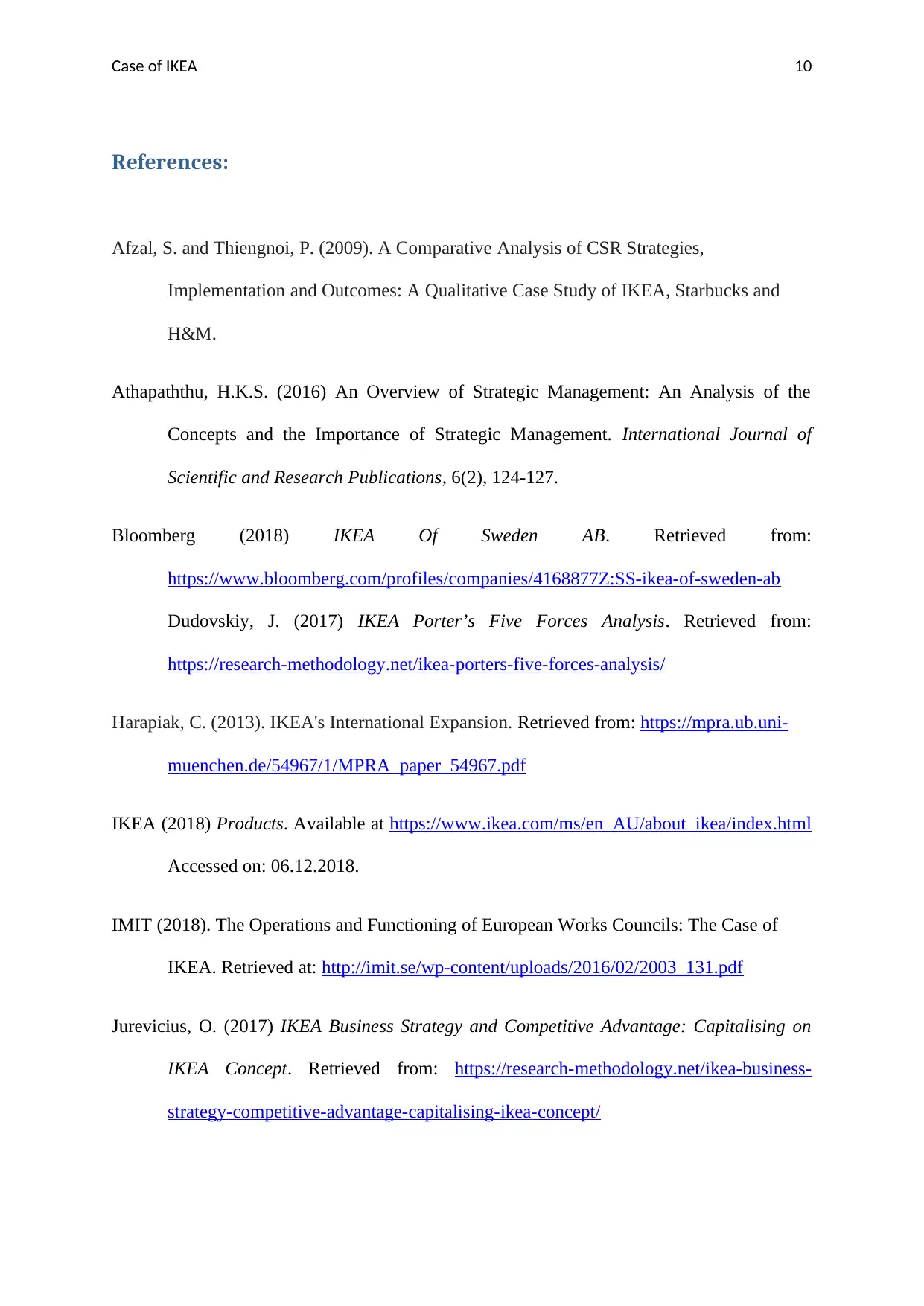
Case of IKEA 10
References:
Afzal, S. and Thiengnoi, P. (2009). A Comparative Analysis of CSR Strategies,
Implementation and Outcomes: A Qualitative Case Study of IKEA, Starbucks and
H&M.
Athapaththu, H.K.S. (2016) An Overview of Strategic Management: An Analysis of the
Concepts and the Importance of Strategic Management. International Journal of
Scientific and Research Publications, 6(2), 124-127.
Bloomberg (2018) IKEA Of Sweden AB. Retrieved from:
https://www.bloomberg.com/profiles/companies/4168877Z:SS-ikea-of-sweden-ab
Dudovskiy, J. (2017) IKEA Porter’s Five Forces Analysis. Retrieved from:
https://research-methodology.net/ikea-porters-five-forces-analysis/
Harapiak, C. (2013). IKEA's International Expansion. Retrieved from: https://mpra.ub.uni-
muenchen.de/54967/1/MPRA_paper_54967.pdf
IKEA (2018) Products. Available at https://www.ikea.com/ms/en_AU/about_ikea/index.html
Accessed on: 06.12.2018.
IMIT (2018). The Operations and Functioning of European Works Councils: The Case of
IKEA. Retrieved at: http://imit.se/wp-content/uploads/2016/02/2003_131.pdf
Jurevicius, O. (2017) IKEA Business Strategy and Competitive Advantage: Capitalising on
IKEA Concept. Retrieved from: https://research-methodology.net/ikea-business-
strategy-competitive-advantage-capitalising-ikea-concept/
References:
Afzal, S. and Thiengnoi, P. (2009). A Comparative Analysis of CSR Strategies,
Implementation and Outcomes: A Qualitative Case Study of IKEA, Starbucks and
H&M.
Athapaththu, H.K.S. (2016) An Overview of Strategic Management: An Analysis of the
Concepts and the Importance of Strategic Management. International Journal of
Scientific and Research Publications, 6(2), 124-127.
Bloomberg (2018) IKEA Of Sweden AB. Retrieved from:
https://www.bloomberg.com/profiles/companies/4168877Z:SS-ikea-of-sweden-ab
Dudovskiy, J. (2017) IKEA Porter’s Five Forces Analysis. Retrieved from:
https://research-methodology.net/ikea-porters-five-forces-analysis/
Harapiak, C. (2013). IKEA's International Expansion. Retrieved from: https://mpra.ub.uni-
muenchen.de/54967/1/MPRA_paper_54967.pdf
IKEA (2018) Products. Available at https://www.ikea.com/ms/en_AU/about_ikea/index.html
Accessed on: 06.12.2018.
IMIT (2018). The Operations and Functioning of European Works Councils: The Case of
IKEA. Retrieved at: http://imit.se/wp-content/uploads/2016/02/2003_131.pdf
Jurevicius, O. (2017) IKEA Business Strategy and Competitive Advantage: Capitalising on
IKEA Concept. Retrieved from: https://research-methodology.net/ikea-business-
strategy-competitive-advantage-capitalising-ikea-concept/

Case of IKEA 11
Palepu, K.G. and Healy, P.M. (2007). Business analysis and valuation. Cengage Learning
EMEA.
Porter, M.E. (2008). On competition. Harvard Business Press.
Schirone, D.A. (2012). Customers’ behaviour analysis in furniture field: IKEA case in the
Northern Part of Bari province. Journal of Knowledge Management, Economics and
Information Technology, 2(6), pp.54-73.
Palepu, K.G. and Healy, P.M. (2007). Business analysis and valuation. Cengage Learning
EMEA.
Porter, M.E. (2008). On competition. Harvard Business Press.
Schirone, D.A. (2012). Customers’ behaviour analysis in furniture field: IKEA case in the
Northern Part of Bari province. Journal of Knowledge Management, Economics and
Information Technology, 2(6), pp.54-73.
1 out of 12
Related Documents
Your All-in-One AI-Powered Toolkit for Academic Success.
+13062052269
info@desklib.com
Available 24*7 on WhatsApp / Email
![[object Object]](/_next/static/media/star-bottom.7253800d.svg)
Unlock your academic potential
© 2024 | Zucol Services PVT LTD | All rights reserved.





